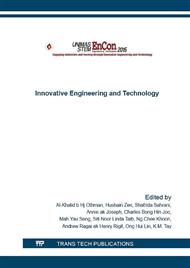p.41
p.49
p.59
p.71
p.78
p.87
p.94
p.102
p.111
Effects of Solvent/Solid Ratio and Temperature on the Kinetics of Vitamin C Extraction from Musa Acuminata
Abstract:
This work studied on the kinetics of Vitamin C extraction from banana peel at different solvent/solid concentration and temperature. Musa Acuminata was ground into smaller sizes before contacted with methanol as a solvent in an ultrasonic bath. To study the effect of solvent/solid ratio, 4.5, 5.0 and 10.0 ml/g ratio were used for the extraction at fixed temperature. Then, the temperature was varied with the heating element available in the ultrasonic bath at 30, 45 and 60 °C, to study the effect of temperature on the extraction kinetics. It was found that high solvent/solid ratio (10 ml/g) provides more solute-solvent contact and prevents the extracted Vitamin C from coming into contact with the air. Besides, higher temperature (60 °C) contributes sufficient kinetic energy for Vitamin C distribution in the solvent which is important to prevent degradation with air. The best fitted kinetic model for Vitamin C extraction from Musa Acuminata is Ana et al. (2007) with equilibrium concentration of 0.05 g/L and 0.40 g/L.hr extraction rate.
Info:
Periodical:
Pages:
78-83
Citation:
Online since:
April 2016
Keywords:
Price:
Сopyright:
© 2016 Trans Tech Publications Ltd. All Rights Reserved
Share:
Citation:


